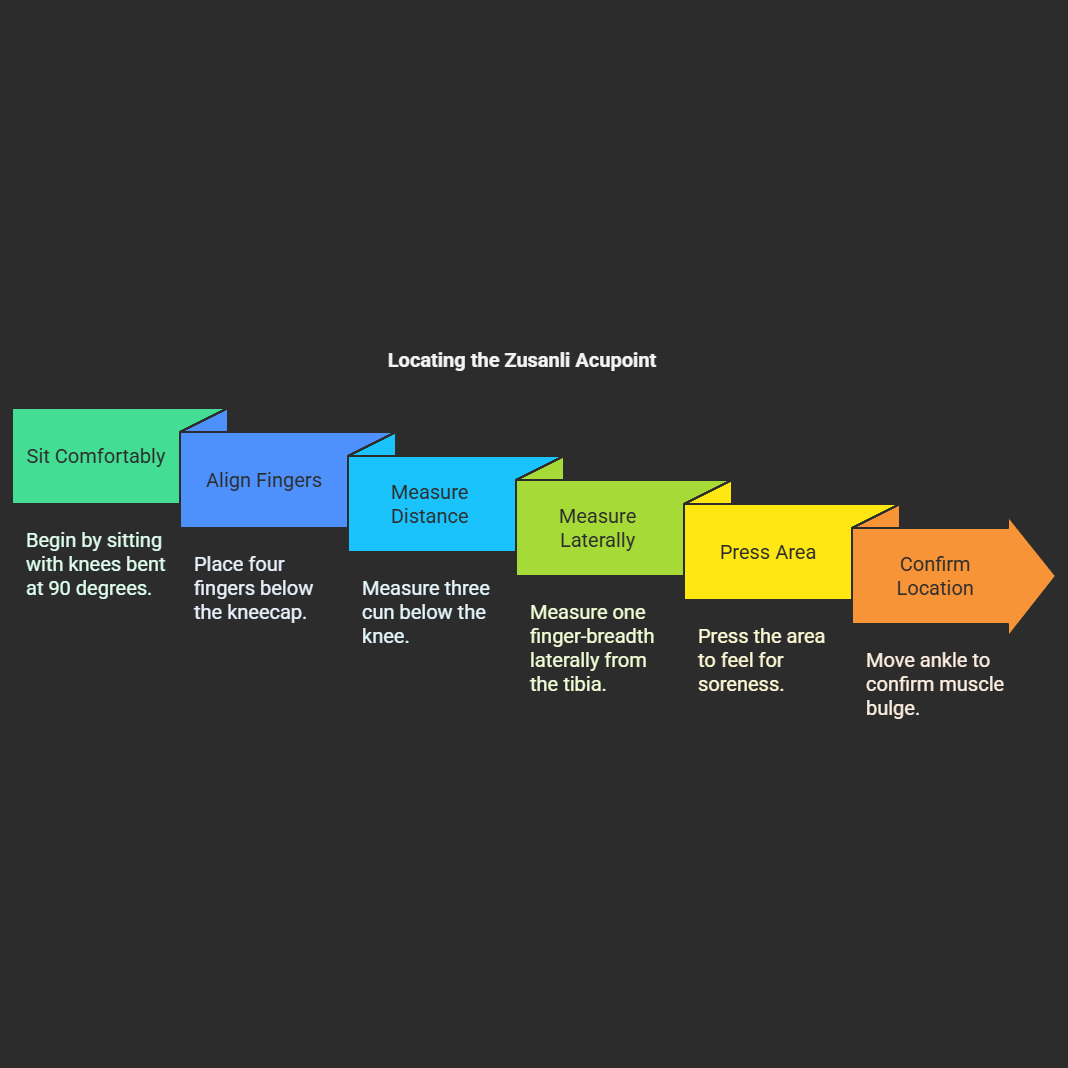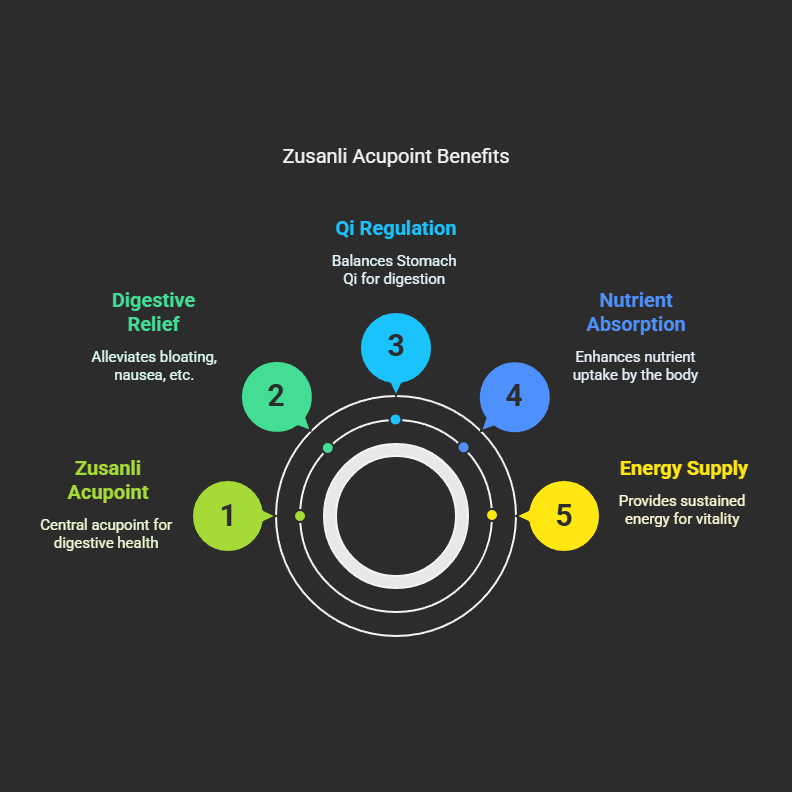Hello everyone, I am your massage therapist. In my many years of practice, I have touched countless bodies and listened to numerous health stories. I have come to deeply understand that true health is far more than just the absence of illness or pain; it is a state of 'Happy Healthy Life' filled with vitality, inner peace, and a radiant spirit. This is a beautiful state that we can actively pursue and cultivate with intention. Today, I want to share with you a powerful wellness companion that originates from ancient wisdom yet perfectly aligns with modern health needs—this is the amazing Zusanli acupoint. Not only is it a pearl in the treasure trove of Traditional Chinese Medicine (TCM), but it is also a key for each of us to unlock the door to a 'Happy Healthy Life.' Let us explore its mysteries together.
The Zusanli acupoint, often respectfully referred to as the 'Longevity Point,' holds a highly significant position in Traditional Chinese Medicine (TCM) meridian theory. Its remarkable quality lies in its broad regulatory capabilities, addressing a wide range of common health concerns we might encounter daily—from minor digestive issues and boosting immunity to alleviating mental fatigue. What's even better is that Zusanli is an acupoint that is very easy to locate and stimulate. This means everyone can easily integrate this ancient wellness wisdom into their busy modern lives, proactively contributing to their own health and well-being. Many classic medical texts and modern research studies alike point to one conclusion: regular stimulation of Zusanli offers significant benefits for enhancing overall vitality and strengthening the body's immune defenses, serving as an important cornerstone for fortifying both body and mind.
Exploring Zusanli: Its Origins, Location, and the Deeper Meaning of Its Name
To experience the remarkable benefits of Zusanli, the first and most important task is to locate it accurately. The method is actually quite simple: First, please sit comfortably with your knees naturally bent at a 90-degree angle. Next, bring the four fingers of your hand (on the same side as the leg you are working on) together, and gently align the top edge of your index finger with the lower border of your kneecap (patella). The horizontal line at the lower edge of your little finger is now approximately three cun (body inches) below the knee. Then, from the anterior crest of your tibia (the prominent bone on the front of your lower leg), measure one finger-breadth (about the width of your own middle finger) laterally (outwards). Press in this area where the muscle is thick; if you feel a distinct sensation of soreness and distension (a dull, aching feeling), that's the Zusanli acupoint. You can also try moving your ankle up and down to feel the slight bulge of the muscle in that spot, which can help confirm the location. This location method is time-tested, ensuring its reliability.

The history of the Zusanli acupoint can be traced back to the foundational text of Traditional Chinese Medicine (TCM), the Huangdi Neijing (Yellow Emperor's Inner Canon), and its importance is self-evident. It belongs to the Foot Yangming Stomach Meridian and is the 'He-Sea' point among the Five Shu points of this meridian. In TCM theory, a 'He-Sea' point signifies a place where the Qi of the meridian converges and penetrates deeply, closely connecting with the corresponding Zang-Fu organs. Therefore, it has powerful and special effects in regulating issues related to these organs. As the He-Sea point of the Stomach Meridian, Zusanli's role in regulating Spleen and Stomach functions is naturally paramount. TCM holds that 'the Stomach is the sea of water and grain' (i.e., the primary receiver of food and drink); the Spleen and Stomach are the source of Qi and Blood generation and transformation, and thus the foundation of our postnatal health. Therefore, Zusanli can not only treat disorders of the Stomach organ itself but, more importantly, by strengthening Spleen and Stomach functions, it nourishes the postnatal constitution and has a profound impact on the generation and distribution of Qi and Blood throughout the entire body.
The Remarkable Efficacy of Zusanli: A Professional Massage Therapist's Perspective on Its Mind-Body Benefits.
In my massage practice, digestive discomfort is one of the most common issues many clients mention. Zusanli belongs to the Foot Yangming Stomach Meridian and is a prime acupoint for regulating Spleen and Stomach functions. There's a common saying in TCM, 'For abdominal issues, turn to Zusanli' (Dù Fù Sān Lǐ Liú), which means that for nearly all abdominal problems, one can seek relief by stimulating Zusanli. Whether it's common issues like bloating, stomach ache, indigestion, nausea, vomiting, constipation, or diarrhea, regular massage of Zusanli can provide significant relief. It works by promoting the normal ascending and descending functions of Stomach Qi, coordinating intestinal peristalsis, and improving the secretion of digestive fluids. This fundamentally enhances the Spleen and Stomach's transportation and transformation functions, helping the body absorb nutrients more effectively and providing an inexhaustible supply of energy for our healthy and vibrant lives.

A strong immune system is our key barrier for resisting external pathogenic factors and maintaining overall health. Zusanli plays an indispensable role in enhancing immunity. Traditional Chinese Medicine (TCM) theory holds that stimulating Zusanli can tonify Qi and Blood and strengthen Wei Qi—our body's defensive energy. Modern medical research has also provided strong evidence supporting this ancient wisdom; multiple studies have found that stimulating Zusanli can increase the number of white blood cells, enhance the activity of immune cells, and actively regulate cytokine levels, thereby comprehensively boosting the body's disease resistance. Therefore, regularly massaging Zusanli is like building a strong protective barrier for our body, helping us to better cope with external environmental challenges and reduce the incidence of illness.
A Comprehensive Guide to Zusanli Massage Techniques: Professional Instruction and Home Self-Care
Mastering the correct massage methods is key to fully experiencing the wellness benefits of Zusanli. As a massage therapist, I will introduce several practical and easy-to-learn Zusanli self-massage techniques, enabling you to easily perform daily health maintenance at home.
The most basic and commonly used method is to use the pad of your thumb or index finger to apply pressure to the Zusanli acupoint. The applied pressure should be moderate, ideally eliciting a local sensation of soreness, numbness, distension, heaviness, or even a slight warmth. This sensation is known in Traditional Chinese Medicine (TCM) as 'Deqi,' which indicates effective stimulation of the acupoint. You can apply sustained pressure or combine it with gentle circular kneading. It's recommended to massage the point for about 2 to 3 minutes each time, once or twice a day. Performing it after waking up in the morning or before bed at night is especially beneficial. Consistency is key; regular stimulation better activates the acupoint's potential to achieve its health preservation and wellness benefits.

In addition to manual massage, Traditional Chinese Medicine (TCM) offers other methods to enhance the stimulation of Zusanli and boost its health-preserving benefits. For example, moxibustion (艾灸 - àijiǔ) is a classic form of heat therapy. It involves holding a lit moxa stick to gently warm the Zusanli acupoint (indirect moxibustion), which can effectively warm and tonify the Spleen and Stomach, dispel cold, and clear the meridians. It is particularly suitable for individuals with a constitution tending towards deficiency and cold. Gua Sha (刮痧 - guāshā) is another commonly used method. After applying an appropriate amount of Gua Sha oil or lubricant to the Zusanli acupoint area, a Gua Sha tool is used to scrape the skin. This technique helps to dredge the meridians, invigorate blood circulation, and resolve blood stasis. However, moxibustion involves working with an open flame, and Gua Sha requires specific techniques and an understanding of one's own condition. If you lack relevant experience, it is advisable to seek guidance and treatment from a professional TCM practitioner or a qualified therapist to ensure both safety and effectiveness.
Massaging Zusanli: Precautions and Contraindications
While massaging Zusanli offers numerous benefits, it's crucial when engaging in self-care to pay particular attention to certain important considerations to ensure the process is both safe and effective and to prevent unnecessary risks.
First and foremost, the most important principle of self-care is to 'act within your limits and proceed gradually.' The pressure applied during massage should not be excessive. Especially for beginners or individuals with a weaker constitution, it's advisable to start with gentle stimulation and gradually find a comfortably acceptable level of that characteristic aching or distending sensation. Absolutely avoid using brute force or excessive pressure, as this could cause unnecessary damage to local tissues or lead to other discomforts. Secondly, avoid directly massaging areas with broken skin, open wounds, redness, swelling, inflammation, or an acute sprain. If there are bruises or noticeable varicose veins directly over the Zusanli acupoint area, you should also avoid massaging there or only apply extremely gentle pressure. Safety always comes first.
For specific groups of people and in certain special conditions, massaging Zusanli requires special caution and may even be contraindicated. Pregnancy is a special period requiring heightened attention. Although experienced TCM practitioners may, in some cases and under professional guidance, use Zusanli to address certain discomforts during pregnancy, this acupoint has a relatively strong stimulating nature and could potentially affect uterine activity. Therefore, pregnant women are strongly advised against self-massaging this point without guidance. It is essential to consult your doctor or a professional TCM practitioner before applying any acupoint stimulation. Furthermore, if the Zusanli acupoint area is experiencing an acute infection or severe inflammation, such as cellulitis, massaging the area should be completely avoided to prevent worsening the condition.
With Consistent Practice, Zusanli Guides You Towards a 'Happy Healthy Life'
However, for any wellness method, no matter how excellent, its ultimate effectiveness is inseparable from the practice of 'perseverance' (持之以恆 - chí zhī yǐ héng). To truly appreciate the many health benefits Zusanli offers, the key lies in applying regular, sustained, and appropriate stimulation to the point. Consider incorporating Zusanli massage into your daily life as a healthy habit, much like brushing your teeth or washing your face. Take just a few short minutes each day to mindfully 'dialogue' with this amazing acupoint. Perhaps it's just a few minutes of gentle pressing and kneading each morning and evening, but over time, you will be delighted to discover subtle yet positive changes occurring in your body—digestion becomes smoother, energy levels feel more abundant, and your resistance seems stronger too.
This precious gift from ancient Eastern wisdom, with its simple and easy-to-practice methods, can inject an inexhaustible source of vitality into your journey towards a 'Happy Healthy Life.' May each of us make good use of Zusanli, this powerful 'Longevity Point' and 'Health-Care Point,' to mindfully nurture our own physical and mental health, and together advance towards a new realm of a healthier, more joyful, and vibrant life. If you encounter any questions during your practice, or wish to learn more personalized wellness advice, you are always welcome to consult a professional massage therapist or a TCM practitioner.
